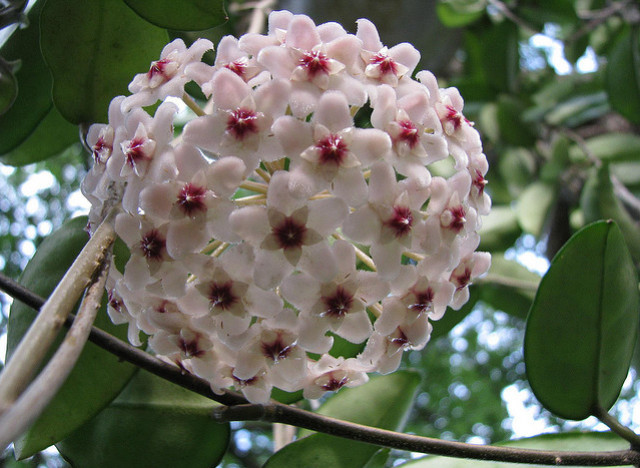
Flickr photo by micklpickl
A very diverse genus identified in 1802, Hoya are native to SE Asia through Australia. Most are somewhat epiphytic with species found in true rain forests while others are found in semi-arid slopes of the Himalayas. They can range in form from vining to shrub like with thick, waxy succulent leaves. The Hoya is a member of the Milkweed family, but here's where roadside milkweed takes an exotic turn. They are prized for their clusters of waxy, wet-looking, sometimes even hairy looking jewel-toned flowers each shaped like a five pointed star. When you come across a Hoya bloom it is hard to believe that it is real. The flowers, or umbels, look as if they belong in a Barbie doll mansion as a hanging chandelier.
There is an abundance of Hoya species, the most common being Hoya carnosa. Hoya generally like bright, indirect light: low light will make flowering less likely, too much direct sun will scorch the leaves. They enjoy a well draining potting mix even a succulent/cactus mix is appropriate for most Hoya - it allows their roots to dry quickly, as it would in their native environment. Allow the top third of the soil to go dry between watering. Keeping their water needs and native environments in mind, it is understandable that they do not like to have ample root space, in fact, being slightly pot-bound is their preferred care. They love being ignored and do not re-pot your Hoya until it is necessary. Hoya re-flower from the spent flower heads, so do not trim it back after blooming.
Yes, Hoya blooms are some of the most fascinating flowers i have ever seen but keep in mind that the Hoya is a shy bloomer in general. Hoya hobbyists can probably be compared to orchid enthusiasts because it takes a while for a Hoya to be comfortable enough to show you what its got but when it does you will not be let down. This one is definitely a collectors plant and it is hard to locate many of the species for sale. If you see one for sale, please promise me you will take advantage of the sighting, pick it up and remember patience is a virtue.